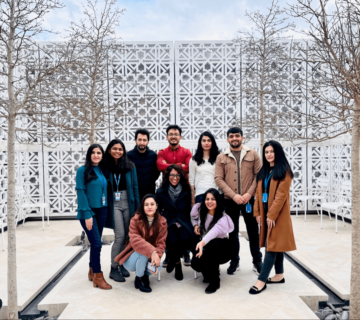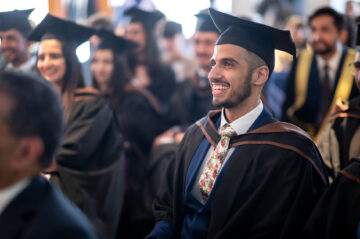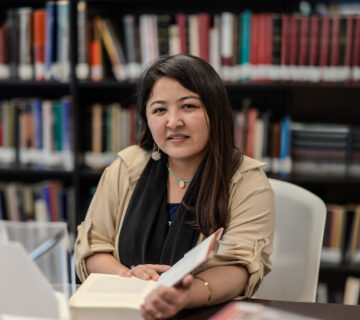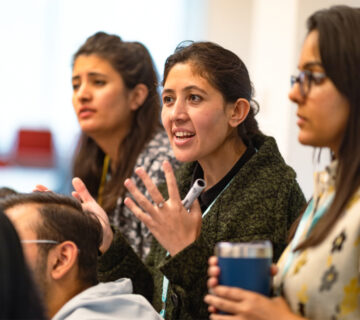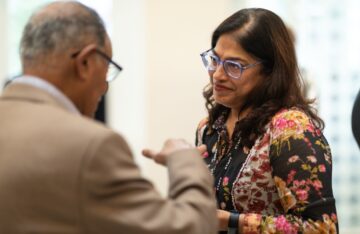The aim of this component of the programme is to offer students direct experience of the lived context of the theories they are exposed to during the Graduate Programme. Students are encouraged to make connections between historical and contemporary issues during this time and to understand the social context of knowledge.
It is also an opportunity for a hands-on experience in designing and developing a research project. Diverse themes were taken up by students for the projects this year including identity, religious authority, resettlement and aesthetics in places as far-flung as Sidhpur in Gujarat, the Darb al-Ahmar district in Cairo, and Khorog in Tajikistan.
One of the students, Aleem Karmali, who was a filmmaker prior to joining the Graduate Programme, elected to explore via a video report what the motivating factors were for Ismaili Muslim refugees who returned to Kampala. A different aspect of resettlement was examined by Munira Shoinbekova who looked at the process of resettlement of the Afghan Ismaili community in Canada during the 1990s.
Two students studied ways in which change affects communities. Amina Nurmamadshoeva’s research project focussed on what the Friendship Bridge means to the people of Badakhshan Tajikistan and Badakhshan Afghanistan. Zarangez Karimova went to Egypt to explore how certain communities respond to activities of external agencies of change.
The identity negotiation of old descendants of Iranian IsmailisAdherents of a branch of Shi’i Islam that considers Ismail, the eldest son of the Shi’i Imam Jaʿfar al-Ṣādiq (d. 765), as his successor. in India was a study undertaken by Mahnaz Yekeh. Keeping to the theme of identity, Zulfiqar Khimani explored how the Ahmadis in Toronto defined themselves as Muslim and the dynamics of identity politics through which the community expresses its identity. Approaching identity from a different angle, Sharmin Khowja elicited narratives from the elders of the Sidhpur community about their conversion in an effort to grapple with why the community changed religious traditions.
In a different part of Asia, Shumaila Hemani undertook to study the tradition, aesthetics and gendered musical practices in the Pamirs by focusing on the spiritual discourse of the Maddoh. In the same part of the world, Otif Somiddinov carried out a case study to understand the notion of religious authority among the Ismaili community of Badakhshan. Using a case study approach in Toronto, Zehra Lalji explored how Muslims relate to Islamic art at the Royal Ontario Museum.
The students of the Class of 2009 are currently completing the third year of their programme and are enrolled on Master’s programmes at several leading universities, including University of Oxford, Goldsmiths and University of Alberta.
The aim of this component of the programme is to offer students direct experience of the lived context of the theories they are exposed to during the Graduate Programme. Students are encouraged to make connections between historical and contemporary issues during this time and to understand the social context of knowledge.
It is also an opportunity for a hands-on experience in designing and developing a research project. Diverse themes were taken up by students for the projects this year including identity, religious authority, resettlement and aesthetics in places as far-flung as Sidhpur in Gujarat, the Darb al-Ahmar district in Cairo, and Khorog in Tajikistan.
One of the students, Aleem Karmali, who was a filmmaker prior to joining the Graduate Programme, elected to explore via a video report what the motivating factors were for Ismaili Muslim refugees who returned to Kampala. A different aspect of resettlement was examined by Munira Shoinbekova who looked at the process of resettlement of the Afghan Ismaili community in Canada during the 1990s.
Two students studied ways in which change affects communities. Amina Nurmamadshoeva’s research project focussed on what the Friendship Bridge means to the people of Badakhshan Tajikistan and Badakhshan Afghanistan. Zarangez Karimova went to Egypt to explore how certain communities respond to activities of external agencies of change.
The identity negotiation of old descendants of Iranian Ismailis in India was a study undertaken by Mahnaz Yekeh. Keeping to the theme of identity, Zulfiqar Khimani explored how the Ahmadis in Toronto defined themselves as Muslim and the dynamics of identity politics through which the community expresses its identity. Approaching identity from a different angle, Sharmin Khowja elicited narratives from the elders of the Sidhpur community about their conversion in an effort to grapple with why the community changed religious traditions.
In a different part of Asia, Shumaila Hemani undertook to study the tradition, aesthetics and gendered musical practices in the Pamirs by focusing on the spiritual discourse of the Maddoh. In the same part of the world, Otif Somiddinov carried out a case study to understand the notion of religious authority among the Ismaili community of Badakhshan. Using a case study approach in Toronto, Zehra Lalji explored how Muslims relate to Islamic art at the Royal Ontario Museum.
The students of the Class of 2009 are currently completing the third year of their programme and are enrolled on Master’s programmes at several leading universities, including University of Oxford, Goldsmiths and University of Alberta.

